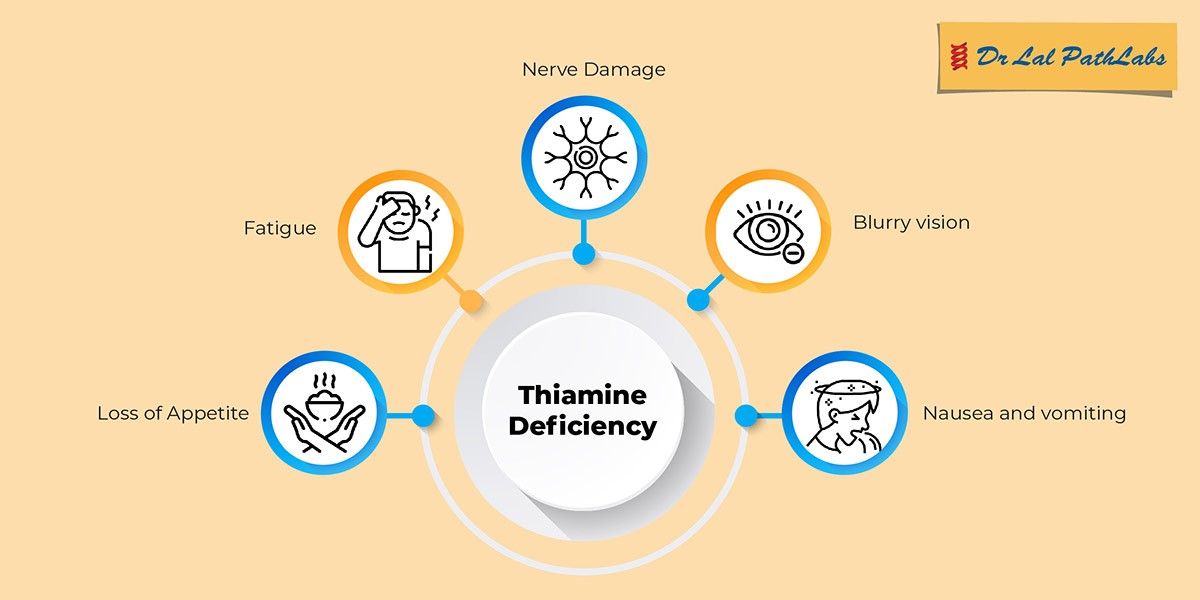Thiamine (Vitamin B1) Deficiency: Symptoms and Diagnosis
What is Thiamine?
Thiamine, also known as vitamin B1, is an essential nutrient that belongs to the B-vitamin family. It plays a crucial role in maintaining the overall health and proper functioning of our body.
Thiamine helps convert carbohydrates into energy, allowing our cells to function optimally. It is also involved in supporting the nervous system, promoting healthy brain function, and aiding in the metabolism of proteins and fats. Thiamine is obtained through various food sources, such as whole grains, legumes, nuts, seeds, pork, and enriched cereals.

A deficiency in thiamine can lead to a condition known as beriberi, which can cause symptoms like weakness, fatigue, nerve problems, and heart issues. Adequate intake of thiamine is important for maintaining overall health and vitality.
What causes Thiamine Deficiency?
Thiamine deficiency can occur due to various factors, including:
- Inadequate dietary intake
- Chronic alcohol consumption
- Gastrointestinal disorders, such as chronic diarrhea or surgical removal of parts of the digestive system, can impair thiamine absorption and lead to deficiency.
- Certain genetic disorders or conditions affecting metabolism, such as maple syrup urine disease or pyruvate dehydrogenase deficiency, can interfere with thiamine utilization and cause deficiency.
- Increased thiamine requirements during pregnancy and breastfeeding can contribute to thiamine deficiency.
- Individuals undergoing long-term dialysis may experience thiamine loss during the process, leading to deficiency if not adequately supplemented.
What are the symptoms of Thiamine Deficiency?
Thiamine deficiency can manifest with different symptoms depending on the type of beriberi. Here are the symptoms associated with each type of beriberi:
Wet beriberi
This type affects the cardiovascular system and may cause symptoms such as:
- Swelling of the lower legs and feet
- Rapid heartbeat
- Shortness of breath
Dry beriberi
This type primarily affects the nervous system and may lead to symptoms such as:
- Muscle weakness and wasting
- Tingling or numbness in hands and feet
- Loss of coordination
- Difficulty walking
- Confusion and memory problems
Wernicke-Korsakoff syndrome
This severe form of thiamine deficiency is often associated with alcohol abuse and can lead to symptoms such as:
- Confusion and memory loss
- Difficulty with balance and coordination
- Visual disturbances, including double vision or eye muscle weakness
What tests are done to diagnose Thiamine deficiency?
The diagnosis of thiamine deficiency is typically based on clinical symptoms, medical history, and laboratory tests. Here are some tests that may be done to diagnose thiamine deficiency:
- Blood thiamine levels: A blood test can measure the concentration of thiamine in the blood. However, it’s important to note that blood levels may not always accurately reflect thiamine status, as thiamine is mainly found within cells and not freely circulating in the blood.
How is Thiamine Deficiency Treated?
Thiamine deficiency is typically treated by replenishing thiamine levels in the body through thiamine supplementation and addressing the underlying cause of the deficiency. The treatment approach depends on the severity and type of thiamine deficiency.
- Thiamine supplementation: The primary treatment for thiamine deficiency involves administering thiamine supplements orally or intravenously.
- Dietary changes: If the deficiency is due to inadequate dietary intake, the individual may be advised to increase their consumption of thiamine-rich foods. Good dietary sources of thiamine include whole grains, legumes, nuts, pork, and fortified cereals.
- Intravenous thiamine: In severe cases of thiamine deficiency, intravenous administration of thiamine is often necessary. This allows for rapid absorption and delivery of thiamine to the body’s tissues.
- Treatment of underlying conditions: Thiamine deficiency can occur because of certain medical conditions that impair thiamine absorption or utilization, such as gastrointestinal disorders or chronic diseases. Treating these underlying conditions is essential to prevent further deficiency.
Please note that the treatment methods discussed here are generic and provided for informational purposes only. It is essential to consult with a qualified physician to receive personalized advice before making any decisions regarding treatment options.
Top 10 Foods Highest in Thiamine or Vitamin B1
Several foods are rich sources of thiamine (vitamin B1). Including these in your diet can help ensure an adequate intake of thiamine. Here are some examples of thiamine-rich foods:
- Whole grains: Whole wheat, brown rice, oats, barley, and quinoa are good sources of thiamine.
- Legumes: Lentils, black beans, pinto beans, navy beans, and chickpeas are high in thiamine. They are also excellent sources of plant-based protein and fiber.
- Nuts and seeds: Sunflower seeds, flaxseeds, sesame seeds, and pistachios contain thiamine. Almonds, pecans, and pine nuts are also good sources.
- Pork: Lean cuts of pork, such as pork tenderloin, contain significant amounts of thiamine. Other lean meats, like beef and poultry, also provide smaller amounts.
- Fish: Certain types of fish are rich in thiamine. Tuna, salmon, trout, mackerel, and sardines are good options. Canned fish, particularly canned tuna, can also be a convenient source.
- Fortified cereals: Some cereals are fortified with thiamine and other vitamins and minerals. Check the labels to find cereals that provide a good amount of thiamine.
- Yeast extract: Nutritional yeast or brewer’s yeast, is a popular source of thiamine among vegetarians and vegans. It can be used as a seasoning or added to dishes for a savory, cheese-like flavour.
- Eggs: Whole eggs, particularly the yolk, contain thiamine. They also provide other essential nutrients.
- Milk and dairy products: Milk, cheese, and yoghurt contain small amounts of thiamine. Choose low-fat or non-fat options to limit saturated fat intake.
- Vegetables: While most vegetables contain small amounts of thiamine, some good options include asparagus, Brussels sprouts, spinach, and peas.
Takeaway
Thiamine deficiency is a condition that should not be overlooked or left untreated, as it can lead to severe complications and long-term health consequences. Seeking medical attention and guidance is essential for the proper diagnosis, treatment, and prevention of thiamine deficiency. With early detection and appropriate intervention, individuals can recover from thiamine deficiency and regain their overall health and well-being.









